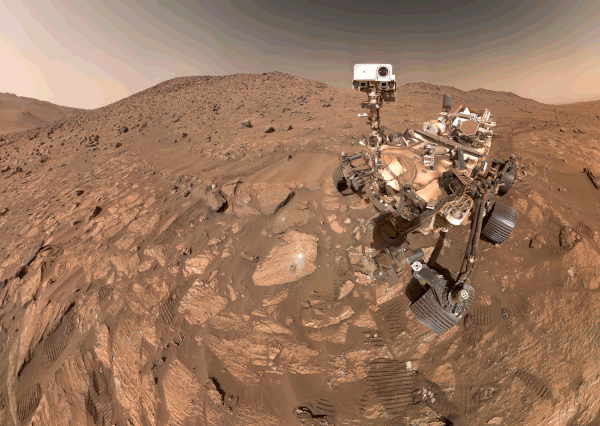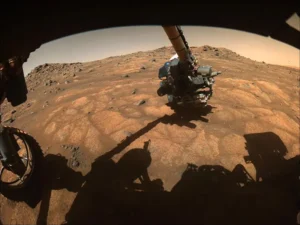Life on Mars? Perseverance Finds Strongest Clue Yet
NASA's Perseverance rover has found the most compelling, yet not definitive, evidence for ancient life on Mars. A rock named "Cheyava Falls" contains a unique map of minerals and organic molecules that looks just like the fossilized leftovers of a microbial meal.

Key Findings
- A rock nicknamed "Cheyava Falls" shows a unique combination of organic carbon and iron-bearing minerals.
- The patterns include vivianite ("poppy seeds") and greigite ("leopard spots").
- This arrangement suggests a potential two-stage microbial metabolic process, a strong biosignature.
- The find is the strongest, though not definitive, evidence for ancient life on Mars found to date.
Primary Source
Source: The Detection of a Potential Biosignature by The Perseverance Rover on Mars
Author(s): J.A. Hurowitz, M.M. Tice, A.C. Allwood, M.L. Cab, et al.
Link: https://www.hou.usra.edu/meetings/lpsc2025/pdf/2581.pdf
For decades, we have stared at Mars, a vast, rusty desert, and wondered if it was always this way. We sent orbiters and landers that confirmed our hopes: billions of years ago, Mars was a world of water, with rivers, lakes, and all the basic chemical ingredients for life. But despite finding these habitable environments, we have never found a single, credible sign of life itself. The hunt has been filled with false positives and ambiguous clues. Therefore, every new “potential” discovery is met with intense excitement and even more intense skepticism. Now, in the dried-up delta of Jezero Crater, the Perseverance rover has found something that scientists are calling our most tantalizing and specific clue yet (a rock that might just be the fossilized leftovers of a Martian meal).
What Is the Core Finding?
The short answer is that Perseverance has found a unique and structured arrangement of organic molecules and specific iron-bearing minerals, all locked together in a rock nicknamed “Cheyava Falls”. This specific combination is significant because it closely resembles patterns on Earth that are created by microbial life. On our planet, microbes “eat” energy-rich molecules (like organics) and “breathe” using other molecules in their environment (like iron or sulfate). This process leaves behind a distinct set of mineral byproducts. The patterns on Cheyava Falls look just like a fossilized record of this exact metabolic process. While not definitive proof, this discovery (detailed in the primary source, above) is the strongest potential biosignature ever found, and it was found in an ancient river delta that was deliberately targeted for its ability to preserve such signs.1Our best proof of life on Mars yet? A deep dive into Cheyava Falls – The Planetary Society, accessed October 12, 2025, https://www.planetary.org/articles/our-best-proof-of-life-on-mars-yet-a-deep-dive-into-cheyava-falls
How Did Scientists Make This Discovery?
This discovery wasn’t an accident; it was the result of a meticulously planned hunt. But how do you perform microscopic geology from millions of miles away? The Perseverance rover uses a pair of high-tech detective tools on its robotic arm. Think of it like a geologist’s toolkit, shrunk down and robotized.
First, the rover uses a high-resolution camera called WATSON to take detailed close-up pictures, just like a geologist using a hand lens. This is what first revealed the strange “poppy seed” and “leopard spot” textures on the rock.2Perseverance Science Instruments, accessed October 12, 2025, https://science.nasa.gov/mission/mars-2020-perseverance/science-instruments/ Once a target is identified, the real analysis begins with two instruments that work together.
The first is SHERLOC. It shines an ultraviolet laser on the rock to map out exactly where organic molecules (the building blocks of life) are located. The second is PIXL, which fires a tiny X-ray beam to map the elemental composition of the exact same spot. PIXL can tell scientists, “Here is iron, here is phosphorus, and here is sulfur.”
The true breakthrough comes from overlaying these two maps. Scientists didn’t just find organic molecules, and they didn’t just find interesting minerals. They found that the organic molecules were located in the *exact same microscopic spots* as the specific mineral combinations. This “correlative micro-analysis” allows them to ask not just “what is this rock made of?” but “how are its ingredients arranged at a microscopic scale?”3In Situ Identification of Paleoarchean Biosignatures Using Colocated Perseverance Rover Analyses: Perspectives for In Situ Mars Science and Sample Return, accessed October 12, 2025, https://pmc.ncbi.nlm.nih.gov/articles/PMC9508457/ This new capability is what allowed them to identify a potential recipe for life, not just a list of ingredients.

Perseverance uses its robotic arm to deploy the instrument turret, containing SHERLOC and PIXL, for close-up analysis of Martian rocks. Credit: NASA/JPL-Caltech
Why Does This Specific Rock Matter So Much?
The excitement isn’t just about finding organic molecules, which NASA has done before. It’s about how they were found, and what they were found with. The patterns on Cheyava Falls tell a story of a potential two-course microbial meal.
What are these “leopard spots” and “poppy seeds”?
The key lies in two specific iron-bearing minerals. The tiny “poppy seeds” and the dark rims of the “leopard spots” are made of vivianite. On Earth, vivianite commonly forms in wet, low-oxygen environments (like bogs or lakebeds) when decaying organic matter reacts with iron. Its presence is a strong clue for very specific chemical conditions.4ohiodnr.gov, accessed October 12, 2025, https://ohiodnr.gov/wps/portal/gov/odnr/discover-and-learn/rock-minerals-fossils/minerals/Vivianite The lighter-colored cores of the “leopard spots” contain greigite. Greigite is an iron sulfide mineral that, on Earth, is often created as a byproduct from bacteria that “breathe” sulfate instead of oxygen.5Greigite – Wikipedia, accessed October 12, 2025, https://en.wikipedia.org/wiki/Greigite
What is a “biosignature”?
This entire discovery centers on the idea of a biosignature. A biosignature is any sign (such as a chemical, a mineral, or a physical structure) that points to past or present life.6astrobiology.nasa.gov, accessed October 12, 2025, https://astrobiology.nasa.gov/education/alp/what-is-a-biosignature/ But there’s a catch. To be a strong clue, it must be something that is very unlikely to form without life. This is the biggest challenge: telling the difference between a real sign of life and a false alarm caused by simple geology.7Biosignature – Wikipedia, accessed October 12, 2025, https://en.wikipedia.org/wiki/Biosignature
So, what story do these minerals tell?
The arrangement of these minerals suggests a two-stage process. First, a community of microbes could have “eaten” the organic molecules in the mud, “breathing” iron oxides (rust) in the rock. This would have produced the vivianite, leaving it behind as a waste product. Later, as the chemistry of the water changed, the microbes may have switched to “breathing” sulfate, which would have produced the greigite in the cores. This layered, specific pattern of organics, vivianite, and greigite is the most powerful biosignature we have ever found because it’s so specific. It’s much harder for simple geology to create this complex, structured arrangement than it is for life.
Have We Been Fooled Before?
This cautious language is for a good reason. The scientific community has been down this road before and has learned hard lessons about an extraordinary claim requiring extraordinary proof.
In 1976, the Viking landers carried experiments designed to find life. One experiment returned a positive result, showing gas being released from the soil as if something was metabolizing nutrients. However, other instruments found no organic molecules, and most scientists now believe the result was caused by exotic, non-living soil chemistry.8The Hunt for Life on Mars – and Elsewhere in the Solar System – NASA Science, accessed October 12, 2025, https://science.nasa.gov/universe/search-for-life/the-hunt-for-life-on-mars-and-elsewhere-in-the-solar-system/
Then, in 1996, a team of scientists announced they have found fossilized microbes inside a Martian meteorite named ALH84001.9Evidence for Microbial Life on Mars: Fossilized Bacteria? | AMNH, accessed October 12, 2025, https://www.amnh.org/learn-teach/curriculum-collections/cosmic-horizons-book/fossil-microbes-mars The evidence included tiny worm-like shapes and specific minerals. Over time, however, other scientists showed how each piece of evidence could have been created by non-biological processes, and the claim is now considered inconclusive at best. This experience is why NASA adopted the “follow the water” strategy that led us to Jezero Crater today.
So, Is It Life or Not?
Despite the amazing evidence, the Perseverance rover cannot give us the final answer. The tools needed to prove life exists (or existed) are far too big and complex to send to another planet.10NASA’s Perseverance Rover Detects Possible Biosignature on Mars – AZoQuantum, accessed October 12, 2025, https://www.azoquantum.com/Article.aspx?ArticleID=641 While SHERLOC can confirm organic carbon is there, it can’t tell us if those molecules are complex biomarkers made by life or by simple geology.11How excited should we be about the latest Mars potential biosignature discovery: ‘It’s arguably the best evidence we have so far’ | Space, accessed October 12, 2025, https://www.space.com/space-exploration/search-for-life/how-excited-should-we-be-about-the-latest-mars-potential-biosignature-discovery-its-arguably-the-best-evidence-we-have-so-far
The only way to know for sure is to bring the “Sapphire Canyon” sample home. This is the entire goal of the Mars Sample Return (MSR) mission, a joint plan by NASA and the European Space Agency. The plan is to send another lander to retrieve the tubes Perseverance has been caching, launch them into orbit, and have another spacecraft catch them for the long journey to Earth.
The discovery at Cheyava Falls makes this mission more urgent than ever. We are no longer just retrieving random rocks. We are retrieving a specific rock that holds our best clue in the search for life. Perseverance has found the question. Now we just need to bring it home to find the answer.12Our best proof of life on Mars yet? A deep dive into Cheyava Falls – Reddit, accessed October 12, 2025, httpss://www.reddit.com/r/Mars/comments/1o3fp8i/our_best_proof_of_life_on_mars_yet_a_deep_dive/


